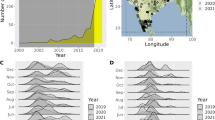Abstract.
Complex recognition systems underlie the social organization of many organisms. In social insects the acceptance of other individuals as nestmates can involve a variety of different cues, but the relative importance of these cues can change in relation to the fitness costs of accepting or rejecting other individuals. In this study we investigate the mechanisms that underlie recognition behaviour in Argentine ants (Linepithema humile). Introduced populations of Argentine ants are characterized by a social structure known as unicoloniality where intraspecific aggression is absent over large distances resulting in the formation of expansive supercolonies. Recent research has identified sites where multiple, mutually aggressive supercolonies co-occur allowing an examination of Argentine ant behaviour at territorial boundaries. We found that workers from different supercolonies always interact aggressively with one another, but that neighbours from different colonies (i.e., workers from nests located in the immediate vicinity of territory borders) consistently exhibited higher levels of aggression compared to those displayed by non-neighbours from different colonies (i.e., workers from nests located far enough away from a territory border so that interactions are unlikely). This difference in the level of aggression displayed between neighbours and between non-neighbours from different supercolonies cannot be explained by differences in relatedness or genetic similarity. Instead our findings suggest that direct contact between mutually antagonistic colonies is sufficient to elevate aggression. A laboratory experiment in which we manipulated the extent to which colonies with no prior history of contact could interact with one another, revealed that aggression increased after colonies were permitted to interact, but dropped after connections between colonies were severed. Moreover, the mere presence of an aggressive supercolony was sufficient to elicit elevated aggression. Overall these patterns are opposite to the “dear enemy” phenomenon and could be the result of the intense territorial aggression exhibited by established supercolonies of this species.
Similar content being viewed by others
Author information
Authors and Affiliations
Corresponding author
Additional information
Received 8 January 2007; revised 27 March 2007; accepted 28 March 2007.
Rights and permissions
About this article
Cite this article
Thomas, M.L., Payne-Makrisâ, C.M., Suarez, A.V. et al. Contact between supercolonies elevates aggression in Argentine ants. Insect. Soc. 54, 225–233 (2007). https://doi.org/10.1007/s00040-007-0935-8
Published:
Issue Date:
DOI: https://doi.org/10.1007/s00040-007-0935-8




